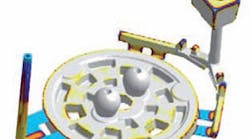Heidelberger Druckmaschinen AG operates one of Europe’s most efficient iron foundries at Amstetten, Germany. It casts the huge cylinders that are critical components of the offset printing presses Heidelberger designs and builds. It also supplies castings to about 50 other customers, large and small castings in different batch sizes. Supplying outside customers is economically advantageous, according to Jürgen Schimmel, director of Pattern & Casting Engineering, and it ensures that Amstetten maintains high quality standards.
“We have a clearly defined goal: economical casting production with consistently high quality. We see casting as part of an overarching process, beginning in design and finishing in reliably functioning, competitive end products,” Schimmel said. Part of the quality initiative is continuous IT support – from component and pattern design to computer-controlled melting and pouring.
The Engineering department uses Magmasoft® casting simulation software to link its computer-aided product design efforts to the metalcasting operation. In effect, casting process simulation allows designers to see inside the mold to understand and predict precisely what will happen during pouring and solidification. As a result, metalcasting engineers can accurately characterize the casting process and predict the finished casting’s properties before production begins.
The engineers use CAD to develop a casting with defined qualities. Accurate production parameters that allow the casting to be produced economically and reliably can be developed with calculable quality. Before simulation became available, each stage of development – from part design through numerous models and tests– had to be exhaustively pursued, and still offered no guarantee that the process would be reliable enough to produce a casting to the requisite quality.
Amstetten uses simulation throughout product and process development, to conserve materials and save costs, and to drive innovation and optimize component integration. For example, developing a “riserless” casting reduced the production of return scrap. Since molten metal contracts as it cools, additional metal usually has to be introduced to the mold via risers in order to avoid defects and porosity. Those factors can be addressed during simulation to reduce return scrap and material consumption. Before investing in Magmasoft, Amstetten calculated simulation would reduce return scrap 8%, which would lower annual material costs by a six-digit figure. Additional cost savings accrue from optimization over the entire process. Thanks to the calculated cooling times, it is safe to run production at the fastest possible rate.
For instance, it was possible to reduce shrinkage cavities significantly while manufacturing a chain guide by reducing riser volumes and altering the gating system. This led to a significant quality improvement, as well as a manufacturing cost reduction estimated at $22.75 per part, primarily because they managedto reduce return scrap by approximately 2.5 kg. Given an annual production of approximately 300 pieces, this is an estimated savings of $6,768. Also thanks to solidification simulation, it was possible to reduce the number of risers from five to two during production of a gear wheel. Together with a 69-kg reduction in return scrap, this lowered manufacturing costs by an estimated $44.65 per part.
Choosing Magmasoft has had numerous advantages for Amstetten: the basic software is provided with a series of modules that cover all casting process production steps. The developer provides user support starting from the design of the component and the selection of the melt treatment and casting layout, through to pattern design and mold production, to final heat treatment and finishing. Magmasoft’s applications cover all cast materials, and every casting process can be simulated in order to design and assess the casting and tooling layouts, cycle times, and casting quality.
“User-friendly operation, short preparation time until start of calculations, realistic representation of results – those were the leading functional criteria when we chose Magmasoft,” explained Hans Friess, director of Planning/Material Management. “And, of course, another factor was the potential for future developments in the software.”
Another positive result has been better communication between the casting designers and the foundry operators. The designers get quick and reliable feedback on new component designs’ castability, and the production crew gets reliable information on how to handle the casting process to achieve the best result. Using the simulation documentation, both parties can propose ideas that can be quickly and easily checked using simulation.










